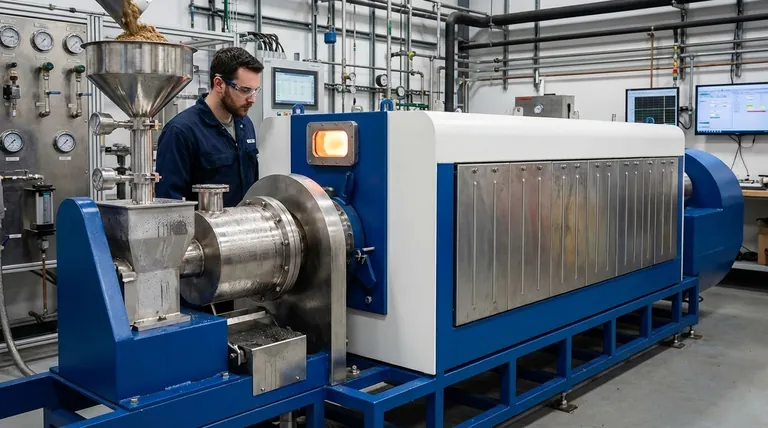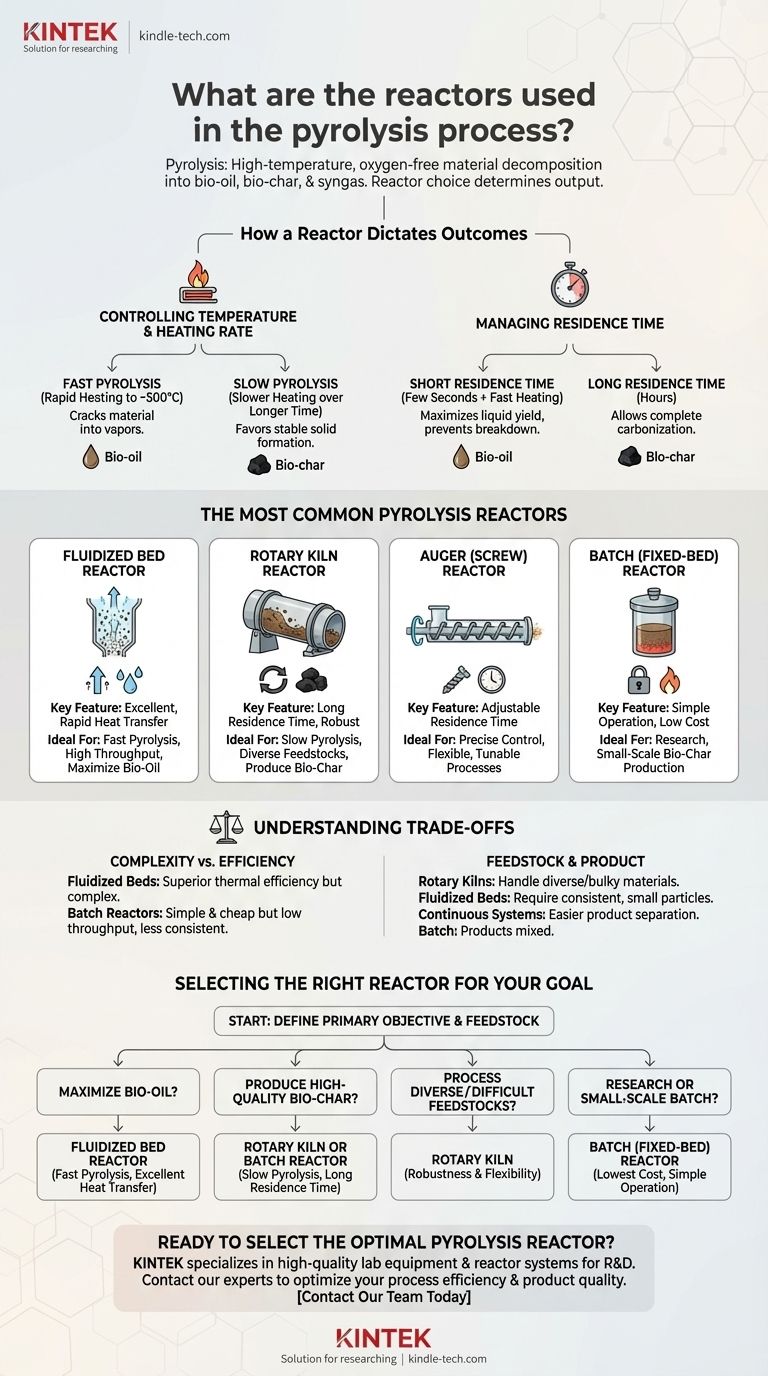In pyrolysis, the most common reactors are fluidized beds and rotary kilns, though many other specialized designs exist. These machines are essentially high-temperature, oxygen-free ovens designed to thermally decompose materials like biomass, plastics, or tires. The specific reactor type chosen is critical, as it directly influences the process conditions and, therefore, the final yield of products like bio-oil, bio-char, and syngas.
The choice of a pyrolysis reactor is not about finding the "best" one, but about selecting the right tool for the job. Each reactor design offers a different way to control temperature and residence time, which in turn determines whether you primarily produce liquid fuel, solid char, or combustible gas.

How a Reactor Dictates Pyrolysis Outcomes
A pyrolysis reactor is more than just a container; it is a carefully engineered system for controlling the core parameters of a thermochemical reaction. Its design dictates the entire process.
Controlling Temperature and Heating Rate
The speed at which feedstock is heated is a primary factor in the product outcome.
Fast pyrolysis, which involves rapid heating to moderate temperatures (around 500°C), "cracks" the organic material into vapors that can be condensed into bio-oil. Reactors that provide excellent heat transfer are required for this.
Slow pyrolysis, by contrast, uses a much slower heating rate over a longer period. This process favors the formation of a stable, carbon-rich solid known as bio-char.
Managing Residence Time
Residence time is the duration the material spends inside the reactor at the target temperature.
A short residence time (a few seconds) is paired with fast heating to maximize liquid bio-oil yield and prevent it from further breaking down into gas.
A long residence time (hours) is characteristic of slow pyrolysis, allowing for the complete carbonization of the material to produce high-quality bio-char.
The Most Common Pyrolysis Reactors
While dozens of designs exist, most commercial and research applications rely on a few key types, each optimized for different goals.
Fluidized Bed Reactors: For High-Throughput and Bio-Oil
A fluidized bed reactor suspends the solid feedstock particles (like sand or biomass) on an upward-flowing stream of hot gas. This creates a turbulent, fluid-like mixture that ensures extremely rapid and uniform heat transfer.
This design is the industry standard for fast pyrolysis because its excellent heat transfer capabilities are ideal for maximizing bio-oil production.
Rotary Kiln Reactors: For Versatility and Bio-Char
A rotary kiln reactor is a large, rotating cylindrical vessel inclined at a slight angle. As the drum rotates, the feedstock tumbles and mixes, gradually moving from the higher end to the lower end.
This design is highly robust and can handle a wide variety of feedstock sizes and types. The slow movement and longer residence time make rotary kilns exceptionally well-suited for slow pyrolysis and the production of bio-char.
Auger (Screw) Reactors: For Precise Control
An auger reactor, also known as a screw reactor, uses a large rotating screw to transport material through a heated tube.
The speed of the screw provides precise control over the residence time of the material. This makes it a flexible option that can be tuned for various pyrolysis processes, though it can be more mechanically complex.
Batch (Fixed-Bed) Reactors: For Simplicity and Small Scale
A batch reactor is the simplest design. A fixed amount of feedstock is loaded into a sealed vessel, heated for a set duration, and then the products are removed once the process is complete.
Because of their straightforward design and operation, batch reactors are common in laboratory research and small-scale, non-continuous production, particularly for bio-char.
Understanding the Trade-offs
Selecting a reactor involves balancing efficiency, cost, and operational complexity. No single design excels in all areas.
Complexity vs. Efficiency
Fluidized bed reactors offer superior thermal efficiency and throughput but are complex systems to operate and maintain, requiring precise control over gas flow and particle size.
Conversely, batch reactors are simple and inexpensive but offer low throughput and less consistent process control compared to continuous systems.
Feedstock Flexibility
A key strength of the rotary kiln is its ability to process non-uniform, mixed, or bulky materials that would jam or disrupt other reactor types. Fluidized beds, in contrast, require feedstock to be ground to a consistent and relatively small particle size.
Product Quality and Separation
The reactor design also impacts the ease of separating the final products. Continuous systems like fluidized beds or augers often incorporate downstream equipment to quickly separate and condense vapors into bio-oil while extracting char and syngas in different streams. In a simple batch reactor, all products remain mixed until the cycle ends.
Selecting the Right Reactor for Your Goal
Your choice must be driven by your primary objective. Analyze your target product and feedstock to determine the best technology path.
- If your primary focus is maximizing bio-oil production: A fluidized bed reactor is the optimal choice due to its excellent heat transfer for fast pyrolysis.
- If your primary focus is producing high-quality bio-char: A rotary kiln or a batch reactor provides the long residence times and slower heating needed for slow pyrolysis.
- If your primary focus is processing diverse or difficult feedstocks: A rotary kiln offers the most robustness and flexibility to handle varied material inputs.
- If your primary focus is research or small-scale batch production: A fixed-bed (batch) reactor offers the lowest barrier to entry in terms of cost and operational simplicity.
Ultimately, understanding the connection between reactor design and process control empowers you to make a strategic and effective technology choice.
Summary Table:
| Reactor Type | Primary Goal | Key Feature | Ideal For |
|---|---|---|---|
| Fluidized Bed | Maximize Bio-Oil | Excellent, rapid heat transfer | Fast pyrolysis, high throughput |
| Rotary Kiln | Produce Bio-Char | Long residence time, robust | Slow pyrolysis, diverse feedstocks |
| Auger / Screw | Precise Control | Adjustable residence time | Flexible, tunable processes |
| Batch / Fixed-Bed | Simplicity & Small Scale | Simple operation, low cost | Research, small-batch bio-char |
Ready to select the optimal pyrolysis reactor for your specific needs? The right reactor is critical for achieving your target yields of bio-oil, bio-char, or syngas. KINTEK specializes in high-quality lab equipment and reactor systems for pyrolysis research and development. Our experts can help you choose the perfect setup to optimize your process efficiency and product quality. Contact our team today to discuss your project and discover how KINTEK's solutions can power your innovation.
Visual Guide

Related Products
- Electric Rotary Kiln Small Rotary Furnace Biomass Pyrolysis Plant
- Electric Rotary Kiln Continuous Working Small Rotary Furnace Heating Pyrolysis Plant
- Customizable High Pressure Reactors for Advanced Scientific and Industrial Applications
- Mini SS High Pressure Autoclave Reactor for Laboratory Use
- High Pressure Laboratory Autoclave Reactor for Hydrothermal Synthesis
People Also Ask
- What is the process of biomass fast pyrolysis? Turn Biomass into Bio-Oil in Seconds
- What are the advantages of pyrolysis technology? Turn Waste into Profit and Reduce Emissions
- What are the conditions for biomass pyrolysis? Optimize Temperature, Heating Rate & Time
- What are the products of pyrolysis of biomass? Unlock Bio-Char, Bio-Oil, and Syngas
- How is energy converted into biomass? Harnessing Nature's Solar Power for Renewable Energy



















